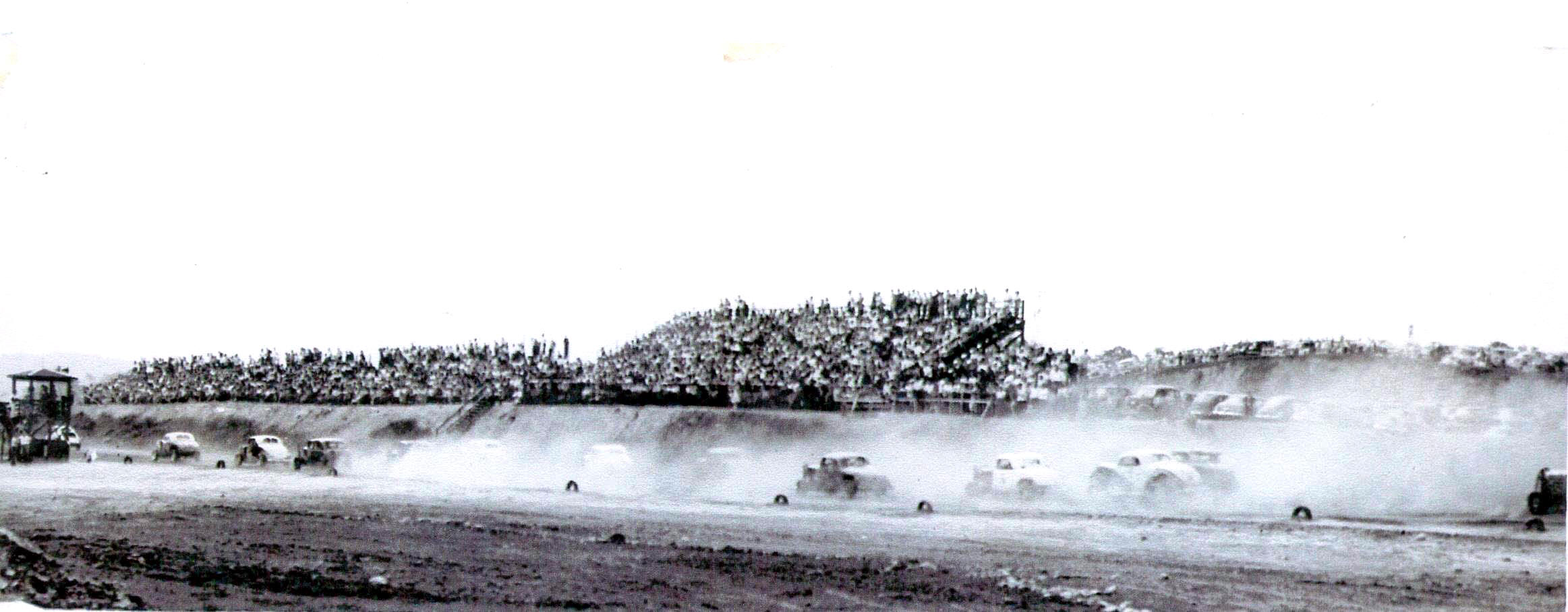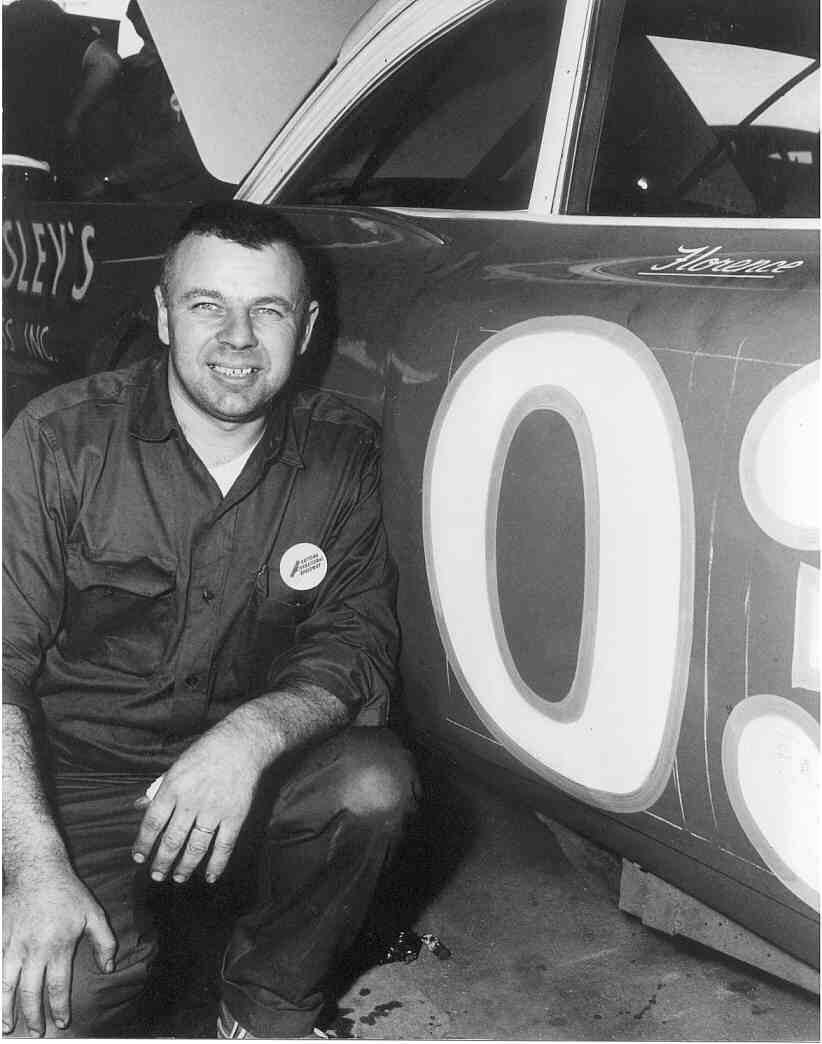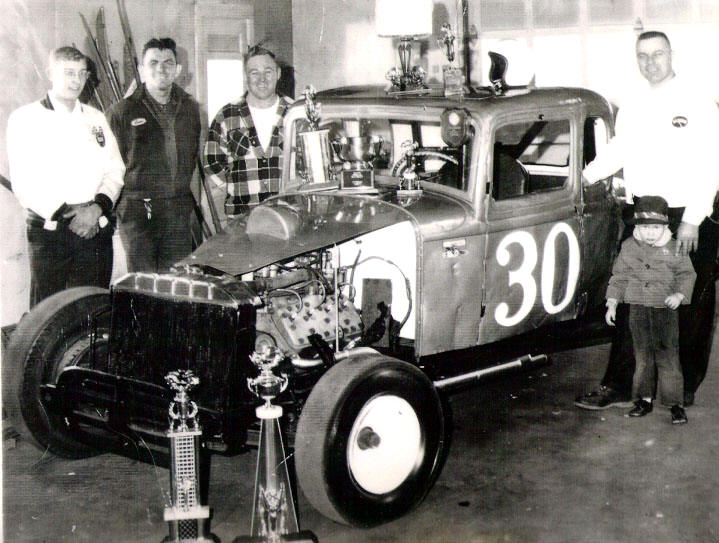|
|
Since I seem to have lost my forum, Mark
Thomas' "Racin' Paper", I will apparently enter the 21st Century and start doing
my column as a
blog. In certain times of the year, this may not be weekly; but I promise to
keep it regular. Many of the site regulars have only been able to
get my columns via this site, anyway, and representing the very newspaper that
was given out at Thunder Road gave me no press courtesies.
So, I might as well do it this way and reach some different readers. Let me know
what you think. -Bill
Week of July 9, 2012
|
|
Hardluck Hanaford : A Second Wave of Stories
[ This was done considerably later than the first Hanaford column. Although there is some overlap, I think this has quite a bit of fresh info, as well. ]
Around 2008, when I had one of my many enjoyable conversations with Plymouth, New Hampshire’s Harold Hanaford, he patiently explained how he had only one “n” in his name – not two, as I had been using in some of my columns. At that time, when I thought of that name, my mind would first refer to the large supermarket chain called “Hannaford”:
Now, with all I know about the man Ken Squier nicknamed “Hardluck”, my first thought process goes to him, with his one “n”; in fact, I often misspelled my grocery checks, since then, as a result.
Harold beats out national champion Rene Charland, who was using a local car at Thunder Road to pick up national points. [Courtesy of Ken Paulsen]
For most of the racing people I encounter around Thunder Road, if they are even old enough to know Harold, he is a winner of big races in the flathead coupes at the Barre, Vermont oval, a man who is honored yearly at the Milk Bowl, and a man a few of them see driving his old coupe around when the New England Antique Racers club visits the track late in June, annually.
There is, however, a lot more to the Harold Hanaford legacy – perhaps more away from Thunder Road that at it. Just as in every other Northeast state, stock car racing was burgeoning in the very early 1950’s in New Hampshire. Tracks were springing up all over the state, in places like West Lebanon, Franklin, Lancaster, and more. Harold watched for a brief while before buying an already – proven car that ran the Franklin Motordrome.
His first racing was done at his hometown track, the Plymouth Fairgrounds, in the winter – on ice – in 1947. In those days, the track ran races all year around, and young Harold not only did his first racing there; but, he met his wife Florence at the races when she actually rode on of her family’s cows over the hill, to the races, from the farm. Florence is quick to point out she was also Miss County Fair there.
The Plymouth Fairgrounds, as they might have looked when Harold was competing there. [Courtesy of Scott Haskell]
Obviously, being a native of Plymouth, Harold was going to run the stock car at the Plymouth Fairgrounds when races were held. At this time, Hanford was still using his first car, a car which he used to barnstorm all over New England. The car, a 1932 Ford flathead with an external roll cage, looked like an ineffective, crude jalopy until one considers that the bracing to the front, now standard in cars, happened more in the early days with the external cage car than with the limited internal bracing in the others.
Hanford bought this car from Franklin Motordrome competitor George Hodgdon and won numerous races all over the Northeast. [Courtesy of Scott Haskell]
Hanaford, who – for the life of him – has never been able to explain Squier’s nickname - actually considers himself somewhat blessed in his career. The many, many victories notwithstanding, he cites an incident at Plymouth to illustrate his being blessed with pretty good luck.
The large Plymouth fair track was, of course, meant for horses and had many structures related to horses in the immediate vicinity. Hanaford recalls today how the fairgrounds track was “too dusty”, which caused an unsafe racing condition, many afternoons. Drivers had little, such as caution lights or in – car radios, to help them know what was occurring ahead.
This may be Pico Raceway, not Plymouth, but the conditions are the same| and so is the general racing era. Harold thinks he may have actually appeared at Pico in his traveling days. [Courtesy of Lew Boyd]
There was a young driver named Langdon Ambrose who raced at Plymouth. Being a welder by trade, he had the best car of anyone at the races.His name made him sound like he should have been competing on the Formula One circuit, over in Europe; but young Langdon was piloting a jalopy on a dusty horse track. Actually, Ambrose once had to admit to Hanaford that – in the dust so thick judges could not see the action – he would cut through the infield to gain an advantage. Trouble, was, once he ran square into the Hanaford car, when he was doing that.
Harold recalls that a fairly serious pileup had caused the red flag to be thrown as he, Ambrose, and several others were just coming past the flagger. Hanaford saw the flag through the dust and started to slow down. He had had enough experience to not just lock up the brakes and stop suddenly under those poor visibility conditions. Ambrose did not see the flag as he followed Harold closely towards the first turn.
When early stock cars were wrecked, they usually stayed wrecked. Maybe this is what Ambrose was thinking as he made his fateful decision. This particular car was a Vermont competitor. [Courtesy of Mark LeFrancois]
Suddenly, there was the nearly – motionless Hanaford #77, immediately in front of the startled Ambrose. He had to make a split – second decision, and he chose not to plow into his friend, Hanaford. Langdon thought he could squeeze through, between Hanford and the old wooden fencing. Sadly, there was nowhere near enough room for Ambrose, who flew through the fencing and into what amounted to a horse ring, used for training competitions during the fair week.
One of the ring’s sturdy posts went right into the Ambrose driver’s car, going up through the floorboards, shearing off his arm, and continuing up through the roof. Jimmy Mayhew, another driver who happened to be flagging that day, had reached the wreck on the run, even before the wreckage had stopped settling. Horrified at what he saw inside the car, he recoiled and then sprang into action. Fortunately for the stricken Ambrose. Whipping off his white racing shirt, Mayhew stuffed it into the cavity left by where the arm used to be. It is all that allowed ,Ambrose to live and to – somewhat later – attend various benefit activities held to help him and his family.
Hanaford also figures some of his other adventures show some pretty favorable luck – just to have survived something he might have said or done off the track. He tells of the time down South, when he, his infamous crewmen, the Havelocks, and a few other Plymouth guys were at Daytona. Using an old school bus to haul a 1959 Pontiac, the same car Cabana and DuBrul had already used down there, the boys found driveshaft starting to chatter something terrible.
Getting the Permatex Pontiac painted and lettered, and then posing with it was unquestionably the easiest part of dealing with the whole Permatex experience. [Courtesy of Marty Little]
Here they were, recalcitrant New Englanders stranded in the heart of a deep South that still was not entirely pleased to have them there. They pulled in to some sleepy old gas station and diner with the usual sleeping hound out front and a number of derelict vehicles parked out back. As it turns out, the diner had a bus just like theirs. While someone went into the diner and kept the school bus driver busy, the others were filching the drive shaft out of the southern bus. They were soon off, again, all set to haul, and lucky there wasn’t a posse of moonshine cars chasing them down with shotguns.
Hanaford was used to having challenging haulers. Once, when they were using a hay truck to get all the way to Barre, VT from Plymouth and back, the old truck broke down. Nonplussed by the setback, the crew hauled the truck home with the stock car.
Harold feels he is more than lucky he survived that trip down South at all. Between the school bus, the uncomfortable speeds on the superspeedway, and the spindle incident, he feels “Good Luck” Hanaford might be a better name to explain away his coming home alive.
When the Cavalcade of Auto Racing featured Thunder Road, around 1964, Hanaford was one of only three drivers whose portraits appeared in the piece. [Cavalcade of Auto Racing Photo]
The crew had the #03 Pontiac running in the Permatex practice sessions and realized they had to have a spindle turned. The went to “this rebel machine shop” somewhere near the speedway. Seeing who the customers were, the guy drawled it would take two days. An exasperated Hanaford, in his best flat Granite State accent, pointed out that they obviously had a race to run before then.
“Two days”, repeated the snotty machinist, who obviously would have gone way out of his way for a southern team.
“No wonder you guys lost the war!” yelled a furious Harold, “You were still waitin’ for the ammunition !” As he left, a large pipe barley cleared his head and crashed against the wall. It is not clear if they were followed or if they ever got it fixed. One thing is for sure – it would have taken a goodly portion of the Confederate army to deal with the unruly Havelock brothers.
Brian Hanford Photo Collection
Hana, with son, Brian, showing off winnings. One of the men in the middle is likely Richard “The Human Jack” Havelock.
Richard Havelock was not Hanaford’s jack man – he WAS Hanaford’s jack. He could back up to the rear of the car, lift it up, and wait until the necessary work was done, He would do this any number of times on a given program. The previous Hanaford column had described two incidents, in which Harold was not paid for feature wins after having defeated the local track owner’s kin.Hardluck recently added detail to the story of the Goodwin race track near West Lebanon, NH, at which the track would not pay him after he beat one of the Goodwin boys. Hana points out that “some old gentleman” they had with them that day decided to take Hanaford’s wire wheels and form cement around them – perhaps for strength, aerodynamics, or who knows why. The Goodwins saw this before Harold could get the cement chipped off, and used that as the excuse why he was illegal. Lucky the Havelocks hadn’t started crewing yet.
Back in the day, Harold checks out a Thunder Road trophy presented to him by Big John Untied and
T Road co – owner Spade Cooley. [Courtesy of Cho Lee]
Before there were the Havelocks, Harold Hanaford enjoyed the services of Robert and Anberg Hennett, another unruly brother act. At the very rustic Ge-Jo-Clin Speedway in Boltonville, he was the visiting guest star, and his car kept stalling, One of the local drivers, “Dirty Dick” Little came forward and began handing Hana a raft of crap. Incensed and already irritated, the Hennetts proceeded to take the Dirty Dick mobile and roll it off the track, down an embankment, and into impenetrable brush. Surprisingly, the boys were invited back to race again. [Many nobody else liked Little, either].
With Milk Bowl titles, the southern survival, an earned reputation as one of the premier touring superstars of early New Hampshire racing, the Ambrose incident, and many other such stories, Harold Hanaford is indeed “Good Luck” Hanaford to be – at his age, healthy and active enough to be about the only flathead star still able to get into one of those old cars and drive around the quarter – mile Barre oval. At least, that is how he feels most of the time. He has had recent surgery but is recovering nicely.I have talked to Harold since this column was done - there could be a third wave of stories at some point.
Please email me at wladabou@comcast.net if you have any photos to lend me or information and corrections I could benefit from. Please do not submit anything you are not willing to allow me to use on my website - and thanks. For those who still don’t like computers - my regular address is: Bill Ladabouche, 23 York Street, Swanton, Vermont 05488.AS ALWAYS, DON’T FORGET TO CHECK OUT MY WEBSITE: www.catamountstadium.com
Return to the Main Page
Return to the Main News Page
Return to the All Links Page
Return to the Weekly Blog Links Page



